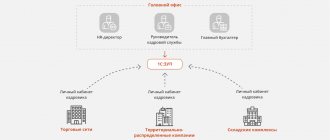Why are employees lazy to work?
There are several reasons why employees don't want to work. A good half of them are the mistakes of the leader himself. The easiest way, of course, is to blame the employees for everything, but honestly, admit it: ideal leaders do not exist. Many of us have our own weaknesses, and this negatively affects the work of the entire team.
So, why do employees mess up?
- That's just how people are. They want to do nothing and get a big salary. This is a common type of people that is becoming more and more common. You can motivate them with one thing - money, but even then not for long. The trouble is that they sincerely believe that they deserve more, and are doing you a favor by the very fact of employment. These need to be disposed of immediately;
- They do not want to work. Because the boss will come and do everything himself. Or he will redo what has been done. Their logic is simple: why bother if the boss will do what’s best anyway. Do you recognize yourself? Then urgently read our article “How to delegate powers” and put the advice of psychologists into practice;
- they do not understand the tasks and responsibilities, so they work carelessly. If an employee does not have a sane job description, his tasks are too vague or completely unsolvable - of course, the desire to work disappears. Be clear about what you want from each employee, for what purpose and within what time frame. It will be easier;
- There is an unhealthy atmosphere in the team: employees weave intrigues, snitch on each other, bosses encourage their favorites and spread rot on the disobedient. If any success of an employee can be turned inside out and turned into failure, even a saint will not want to work. In this case, you first need to unite the team, and then motivate everyone.
Either way, you need to believe in your employees first and then read on. Promise yourself that the team of your online store will be the most successful, the most united. And the manager who forgets to call the client back, and the courier who confuses the addresses, and even the designer who works remotely and misses all the deadlines - they will all definitely cope.
Did you believe it? Exactly? Great. Let's consider different types of incentives for employees: let's call them conditional financial incentives, prospects for the future, a kind word and unusual types of motivation.
How to apply it correctly in practice
Before you start motivating employees, you should determine the priorities of the contingent. Typically, the use of each component of the incentive system is accompanied by careful monitoring of the following indicators:
- work efficiency before the introduction of motivating measures;
- staff performance;
- the labor market as a whole;
- economic indicators in general.
It is these data that help to build a general policy, focusing on the first category of motivation tools.
It is necessary to determine the expenses that the enterprise “can afford”. And then find out what the employees themselves want. Non-material incentives should not be underestimated, because an employee takes a job not only to receive a salary, but also to improve skills, social status and based on other personal motives. Career growth may be significant for some employees, but not have the stimulating basis of this motivation for others.
https://youtu.be/pR9AMU1luc8
Types of staff motivation
Material incentives
The simplest type of motivation: no need to immerse yourself in psychological exercises, delve into the needs of each employee - just give more money. As a rule, this works: no one has ever refused money. But there are also nuances: there is a special type of people for whom human relations or work for the benefit of the Big Idea are more important. Let's talk about finances first, and then return to romantics and subtle natures.
Statistics: ways to motivate staff
1. Increase in wages. At least by 5-10 percent. If you have few employees, these extra expenses are unlikely to greatly affect the profits of the online store, and employees are highly motivated. The first months after the increase, your entire team will simply fly with happiness!
This type of motivation also includes awarding bonuses - for example, a manager can be rewarded for a record number of closed orders, a courier for processing many addresses, an accountant for successfully completing reports, a marketer for a successful advertising campaign. If a person achieves the goal 100%, pay him a 100% bonus; if he achieves 80%, let the amount be less.
2. Discounts on services. Surely your employees have their eye on something from the assortment of your online store, or maybe they are already actively placing orders. Establish corporate discounts once and for all: team members can buy products with a 30% or other nominal discount. This will not only increase your profits, but will also encourage employees to work as word of mouth: let them tell everyone about your kindness and generosity, and at the same time advertise your products.
3. Payment for training. Now you can send employees to courses and trainings: individual and team. This helps unite your team and gives employees new knowledge. Don’t spare money on training: in the end, these costs will come back to you a hundredfold when employees begin to apply the experience gained in practice.
Factors of employee engagement and motivation
4. Renovating the office, buying furniture, arranging a dining room or rest room in the office. It seems that the employee does not receive anything in cash - but you are investing in his comfort. It is known that the convenience of the workplace directly affects labor productivity: try hanging on the phone all day while entering data into the CRM system with the other hand! Buy comfortable, ergonomic furniture for your employees, paint your office in bright, positive colors, and allow employees to have lunch and rest in a specially designated area.
5. Presentation of gifts. And these are not only traditional envelopes and bouquets for birthdays and March 8th. Employees should be rewarded not because of holidays, but because of a job well done. Remember how Soviet factories used to reward the best employees: they gave watches, vouchers to sanatoriums, hung photographs on the honor board and in corporate media. Take these ideas into service - even if not on an industrial scale. Among modern managers, resort packages, gym memberships, tickets to a show or performance are popular - just, of course, find out your employee’s preferences in advance.
Reward the best employees, write about it on the website and in the communities of the online store, on social networks - let customers know their heroes! If your company participates in professional competitions, try nominating your candidate in some category.
6. Pleasant little things. Material rewards can be replaced with other very tangible incentives: extra days off, free lunches, corporate mobile communications, medical insurance, the opportunity to leave work if necessary. And all this without unnecessary red tape, countless signed papers - simply at the will of the boss.
Future prospects
If you have far-reaching plans for an employee, tell him about it. Many leaders strive to make a career and move up the ladder - if they are absolutely sure that they will receive a promotion, they can easily do without an increase in salary or bonus. Your task is to keep your word: deception and destroyed hopes will not be forgiven. The market for your niche is not that big, and bad rumors can spread quickly.
Good word
So we got to those for whom human relationships are more important than salary. These are mainly women who go to work largely because of the good psychological climate, pleasant colleagues, and friendly atmosphere.
1. Praise. Many bosses consider it beneath their dignity to praise an employee once again. Meanwhile, praise, even said casually or on an insignificant occasion, will do more than dry instructions and strict adherence to instructions. A simple “thank you” or “well done” - and now your employee smiles and does his task in a good mood, and the rest of the employees become loyal to you.
2. Possibility of communication between boss and subordinate. Employees often have questions that they have no one to discuss with: the manager rarely appears at work, and if he does come, he locks himself in his office and holds meetings. The rest of the colleagues are performing their tasks and cannot suggest a solution. Make a rule: communicate with employees at least an hour a day. They should know that in the event of force majeure, or even just like that, they can come to you and get practical advice or instructions.
3. Everyone has the right to vote. It often happens that the most lively members of the team come up with suggestions and ideas - the rest are shy or keep silent. Over time, such employees are no longer asked at all; they turn into gray shadows of more successful colleagues. If you have such silent people, give them a chance to prove themselves. Conduct a brainstorming session, a team game, a joint event. In unusual conditions, people reveal an unexpected side: perhaps it is the gray mouse who will come up with the most profitable idea.
4. Honor board. An old method that really works. Hang a stand in your office with the title “best employee of the month” and periodically update photos on it. Be sure to duplicate information on the company website in the news section or on social networks. Don't forget to reward the winner with treats or nice little things.
Honor board in the organization's office
5. Flexible schedule. How many unfortunate “night owl” salespeople come to work at 9 am and then toil until lunch, unable to wake up. And the poor “larks” - couriers idle during their most productive hours - in the morning, and in the evening, pumped up with energy drinks, they deliver orders home. Meanwhile, people’s lives can be made significantly easier by allowing them to work flexible hours or remotely. If you have remote employees, you already know that the quality of work does not suffer from the territorial factor. People know their tasks and deadlines, and whether they do them late at night or in the morning is none of your business.
Unusual ways
1. Taking into account the temperament of employees. Melancholic people work differently than choleric people, and phlegmatic people differ from sanguine people. We've already written about how to work with clients of all different personality types—the same principles can be applied to your own employees. Determining the type is simple: if you don’t want to understand in detail the personality of a subordinate, just conduct psychological testing.
2. Playing on ambition. This method was invented by Walt Disney, and now many managers have picked it up. In the empire of the famous animator there were many departments and positions, some prestigious, others not so much. The most unpopular were hotel laundries: people didn’t want to work there - it wasn’t prestigious. Disney renamed the laundry departments textile services: it sounded different and put workers on the same level as other departments. That is, nothing has changed except the name, but how pleasant it was for the employees! Nowadays, this method is also popular: the cleaning lady is proudly called the housekeeping manager, the laundress is the laundry operator, and so on.
3. Internal reward system - not from superiors, but from your own colleagues. The idea is simple: a corporate program is created in which everyone publicly leaves reviews, thanks or complaints about the work of their colleagues. Now it’s even easier to do this: in any messenger, special corporate chat, business application.
Employee motivation
Motivation system as a strategy management tool*
* Ending.
For the beginning, see “DO” No. 4-6, 2007. Motivation and stimulation of personnel are based on a system of balanced performance indicators (BSC methodology). Systematic approach The strategic goal in terms of personnel management in our company is the high performance of qualified personnel who are satisfied with their working conditions and committed to the company’s values. This is achieved by: — development of “human capital” — selection, retention and development of qualified, professionally competent employees. — development of organizational capital, which is created by the organizational structure, corporate culture, material and non-material motivation programs. A systematic approach to personnel motivation is a comprehensive consideration of the psychological principles of the motivational process of individual and group activity. In my opinion, the fundamental approach to understanding human behavior during the work process is the theory of Alexander Maslow, in which the author divided human needs into five main levels according to a hierarchical principle. Maslow suggested that a person, when satisfying his needs, moves like a ladder, moving from a low level to a higher one. An improved version of Maslow's pyramid (see figure) identifies three main types of human behavior that are essential for an organization. Taking into account all three possible “characters” of figures and types of behavior allows us to implement a systematic approach in developing a system of motivation and incentives for personnel. Elements of a systematic approach to personnel motivation are: - management by objectives; — managing changes in employee behavior and expectations; — development of work content. Management by Objectives (MBO - Management by Objectives) involves regular interaction between managers at all levels of management and subordinates to clarify goals and jointly develop tasks corresponding to them. I consider it necessary to recommend the use of this approach to motivate top and middle managers. Employee motivation is directly related to the achievement of the company's business goals. We use the process of positive change in employee behavior and expectations, which contributes to the improvement of the situation in the company, to consolidate, repeat and strengthen it. To manage the process of changing the behavior of a seller or manager, it is necessary to: - provide training to employees in the desired behavior; — consolidate the desired behavior in the corporate culture (values, current norms and rules); — observe and record all changes in employee behavior and adequately assess their consequences for the company; — timely and proportionately reward employees for their behavior; - constructively criticize employees; - Demonstrate standard behavior by personal example.
A systematic approach to motivation also includes regular job redesign and job enrichment. As part of the strategy of continuous improvement of the company's business processes, this approach is especially relevant. To enhance motivation for work activity, we use changes in the nature of work (rotation, or periodic movement of an employee from one type of work to another). Thus, the redistribution of product categories between managers of the company’s purchasing department not only increased the department’s performance, but also motivated managers to improve their personal performance and improve their competence. The personnel motivation system, as a management element, must meet the interests and goals of the company. In our company, the motivation system is based on the BSC methodology (balanced scorecard system), described in “DO” No. 4. Strategy, goals and objectives are implemented by people - managers, staff, for whom unique beacons are needed that indicate the path at the horizontal level and make it possible to control the correctness of the chosen path vertically. A set of key indicators allows you to translate the strategy into a convenient form, which reveals the strategy to the employee through selected goals and indicators, and also allows you to evaluate employees based on the results of their work. Three elements of the motivation system The motivation system can be represented by three elements: 1. Material motivation. 2. Non-material motivation. 3. Personal responsibility and control. Material motivation We have created a system of material indicators, which includes, at the first level, the distribution of salaries and social packages depending on the status of the employee - his value to the company in terms of business goals and the set of functions of his position. The salary system was harmonized and a grade system was developed. At the second level, a bonus system has been implemented, based on the distribution of the bonus fund depending on the achievement of set goals; the types and sizes of individual and collective bonuses have been determined. The remuneration system defines the ratio of the fixed and variable parts of remuneration, the structure of the compensation package for various categories of employees (food, transportation costs, etc.). As a motivation tool, we use a system of bonuses for continuous service in the company, and we plan bonuses based on the results of the training program. Personal responsibility and control is focusing the activities of each employee on achieving set goals and monitoring key indicators (described in “DO” No. 6). Non-material motivation In the aspect of non-material motivation, we can highlight: - opportunities for career growth - criteria for vertical and horizontal promotion, career growth horizons for employees; - opportunities for professional training and development - development plans, including a training program and obtaining the necessary professional skills; — corporate culture of the company — a system of norms and values inherent in the company, as well as the transmission of norms and values to employees. We use motivational influence at all levels - individual (personal), collective (group) and organizational. At the personal level, we apply all three types of motivation: attraction, retention and effective work. The effectiveness of staff motivation at the personal level is associated with meeting the employee’s expectations of his contribution to the activity, and it is determined by: - the clarity of tasks and their compliance with the employee’s competence and interests; — creating and maintaining conditions for the disclosure and rational use of employee potential; — creating conditions for employee growth and development. I would like to note that more than 70% of store directors are employees who were “raised” within the company, committed to its values and knowledgeable about business processes. The key task of collective motivation is to maintain a balance of interests of different categories of specialists. The presence of individual awards and professional competitions are separate elements of motivation at the personal level. At the group level , we motivate effective and efficient group work and create optimal conditions for collective interaction. The principles of collective motivation should be trust and openness, whether it is a supermarket sales shift or central accounting. The most important feature of motivation at the group level is the influence of relationships between group members on group performance. Collaborative relationships based on trust and mutual understanding cause a synergistic effect, contribute to effective collective group work and increased motivation to achieve a collective task. We carry out collective motivation through: - taking into account the complementary abilities and the existing balance of roles of group members; — clear criteria for assessing the contribution of each group member and developing personal responsibility for the result; — education and training on team building, development of cohesion and cooperation among group members. Factors of effective motivation at the organizational level are the image of the organization and the reputation of its managers, the ability of management to maintain the value of material and non-material motivation incentives, optimal forms and methods of incentives. A fair and understandable system of personnel assessment and remuneration in the company plays a decisive role at this level. Involvement of employees in company management processes, delegation of authority, secured by job descriptions and encouraged by managers, are strong motivating factors. Holding office meetings in the format of round tables, freely discussing problems and draft solutions, taking into account the opinions of managers at different levels and areas of activity can be considered part of the motivation system. I would like to emphasize that managerial competence and motivation to achieve results serve as connecting links that unite all levels of motivation into a single system that can ensure the attraction and retention of talented employees, as well as the rational use of their personal and group potential. Nothing motivates a person more than respect for his personality, rights and opportunities. Not a simple declaration, but propaganda and development, the personal example of the company’s management, form the corporate values of our team. A respectful attitude towards a colleague, a subordinate - a store director, a salesperson or a loader, a desire to provide safe and comfortable working conditions, the absence of fines and material penalties - all this creates the basis for non-material incentives for work. Supporting these values at all levels of management and control, production and service provides the company with high staff commitment and motivation to work, and reduces staff turnover. In our non-financial motivation system, we use team building trainings, conferences, general meetings and classes at the company’s training center, sports and corporate events. Part of the non-material motivation can be called information sources: printed publications, our corporate Internet site. We widely use corporate certificates, medals, and gifts for the winners of contests and competitions. Presenting certificates and congratulating employees on their birthdays and on the opening day of the store have become a tradition. The main body for managing the development processes and improving the systems of motivation, evaluation and remuneration of personnel is the company’s personnel department, the goals and objectives of which are determined by the head of the organization. discuss the article Alexander Sikachina manager
Motivating remote employees
Even if a person is far from you, he should feel involved in your common cause. For freelancers, what is more important is not even material motivation (this is the simplest thing), but a kind word and praise from the boss. It depends on you whether he will become part of the team and be able to work with you for many years. How to motivate a remote employee?
- meet each employee personally, communicate online, arrange video meetings, Skype calls;
- personally give specific tasks and periodically demand reports;
- tell us more about your plans and the future of the online store. Ask the freelancer what he is ready to do;
- invite a remote employee to your office or to your city - preferably at your expense. No phone calls can replace personal acquaintance;
- hold joint events, conferences, trainings, team building.
And, perhaps, the most important thing is to be passionate about your work. Believe in the success of your online store and instill this faith in your employees. Let everything work out!











